Improvement of Traveling Salesman Problem Solution Using Hybrid Algorithm Based on Best-Worst Ant System and Particle Swarm Optimization
Abstract
1. Introduction
Organization and Notation of Paper
2. Max and Min Ant System
- To enhance the capacity of searching, highest value is set for every path of initial pheromone.
- In order to update pheromone, just ant with closest path is allowed in an iteration, which is measured as follow.where addresses the briefest length in the current emphasis:
- To stay away from untimely assembly of the calculation, the pheromone centralization of every way () is restricted to [, ] and the worth past this reach is persuasively set to or .
3. Brief Review on PSO
4. Ant Colony Optimization
5. The Proposed Best-Worst Ant System
Best-Worst Performance Update Rule
6. Combined Algorithm of PSO and ACO
6.1. Strategy
| Algorithm 1 Pseudocode: Hybrid ACO-PSO |
| PSO initialization: For d = 1 to D MMAS introduction: While (not arrive at the most extreme cycles of MMAS) for i = 1 to i For n = 1 to K Determine target city as per condition (1) Udate Taboo Table end end Calculate the length of every subterranean insect way; Find the ideal arrangement, the most exceedingly terrible arrangement and the worldwide ideal arrangement of this emphasis; Update worldwide pheromone utilizing condition (5); end; Set the most brief way length as the wellness work esteem; Update the speed and position of every particle; end |
6.2. Pheromone Trail Mutation
6.3. Restart of the Search Process When It Gets Stuck
| Algorithm 2 Pseudocode: Best worst ant system algorithm. |
| Give an initial pheromone value, to each edge For n = 1 to k do (in equal) Place insect n in an initial hub s and incorporate s in While (insect n not in an objective hub) do Select the following hub to visit, r∉ by the AS change rule. For = 1 to m do Run the nearby pursuit enhancement for the arrangement created by subterranean insect n, . worldwide best subterranean insect visit. current most noticeably terrible insect visit. Pheromone dissipation and Best-Worst pheromone refreshing. If (Stop Condition isn’t fulfilled) go to step 2. |
7. Result and Discussion
8. Conclusions
Author Contributions
Funding
Conflicts of Interest
References
- Osaba, E.; Del Ser, J.; Sadollah, A.; Bilbao, M.N.; Camacho, D. A discrete water cycle algorithm for solving the symmetric and asymmetric traveling salesman problem. Appl. Soft Comput. 2018, 71, 277–290. [Google Scholar] [CrossRef]
- Ghiani, G.; Manni, E.; Thomas, B.W. A comparison of anticipatory algorithms for the dynamic and stochastic traveling salesman Problem. Transp. Sci. 2016, 46, 374–387. [Google Scholar] [CrossRef]
- Hore, S.; Chatterjee, A.; Dewanji, A. Improving variable neighborhood search to solve the traveling salesman problem. Appl. Soft Comput. 2018, 68, 83–91. [Google Scholar] [CrossRef]
- Ezugwu, A.E.S.; Adewumi, A.O. Discrete symbiotic organisms search algorithm for travelling salesman problem. Expert Syst. Appl. 2017, 87, 70–78. [Google Scholar] [CrossRef]
- Rahman, M.A.; Ma, J. Probe Machine Based Consecutive Route Filtering Approach to Symmetric Travelling Salesman Problem; Shi, Z., Pennartz, C., Huang, T., Eds.; Springer: Cham, Switzerland, 2018; Volume 539, pp. 378–387. [Google Scholar]
- Yin, L.; Li, X.; Gao, L. A new improved fruit fly optimization algorithm for traveling salesman problem. In Proceedings of the 2016 Eighth International Conference on Advanced Computational Intelligence (ICACI), Chiang Mai, Thailand, 14–16 February 2016; pp. 21–28. [Google Scholar]
- Li, H.; Chen, J.; Huang, Q. An improvement of fruit fly optimization algorithm for solving traveling salesman problems. In Proceedings of the IEEE International Conference on Information and Automation, Hailar, China, 28–30 July 2014; pp. 620–623. [Google Scholar]
- Iscan, H.; Gunduz, M. An application of fruit fly optimization algorithm for traveling salesman problem. J. Procedia Comput. Sci. 2017, 111, 58–63. [Google Scholar] [CrossRef]
- Marinakis, Y.; Marinaki, M. A hybrid multi-swarm particle swarm optimization algorithm for the probabilistic traveling salesman problem. Jouenal Comput. Oper. Res. 2010, 37, 432–442. [Google Scholar] [CrossRef]
- Gao, S.; Han, B.; Wu, X. Solving traveling salesman problem by hybrid particle swarm optimization algorithm. J. Control. Decis. 2015, 19, 1486–1489. [Google Scholar]
- Riffi, M.E.; Bouzidi, M. Discrete cuttlefish optimization algorithm to solve the travelling salesman problem. In Proceedings of the 2015 Third World Conference on Complex Systems (WCCS), Marrakech, Morocco, 23–25 November 2015; pp. 1–6. [Google Scholar]
- Ismkhan, H. Effective heuristics for ant colony optimization to handle large-scale problems. J. Swarm Evol. Comput. 2017, 32, 140–149. [Google Scholar] [CrossRef]
- Zhong, Y.; Lin, J.; Wang, L.; Zhang, H. Hybrid discrete artificial bee colony algorithm with threshold acceptance criterion for traveling salesman problem. Inf. Sci. 2017, 421, 70–84. [Google Scholar] [CrossRef]
- Osaba, E.; Yang, X.S.; Diaz, F.; Lopez-Garcia, P.; Carballedo, R. An improved discrete bat algorithm for symmetric and asymmetric Traveling Salesman Problems. Eng. Appl. Artif. Intell. 2016, 48, 59–71. [Google Scholar] [CrossRef]
- Saji, Y.; Riffi, M.E. A novel discrete bat algorithm for solving the travelling salesman problem. Neural Comput. Appl. 2016, 27, 1853–1866. [Google Scholar] [CrossRef]
- Kóczy, L.T.; Földesi, P.; Tüű-Szabó, B. Enhanced discrete bacterial memetic evolutionary algorithm—An efficacious metaheuristic for the traveling salesman optimization. Inf. Sci. 2018, 460, 389–400. [Google Scholar] [CrossRef]
- Ouenniche, J.; Ramaswamy, K.; Gendreau, M. A dual lpcal researhework for combinatorial optimization problems with TSP application. J. Oper. Res. Soc. 2017, 68, 1377–1398. [Google Scholar] [CrossRef]
- Yin, D.; Du, S.; Wang, S. A direction-guided ant colony optimization method for extraction of urban road information from very-high-resolution images. J. IEEE J. Sel. Top. Appl. Earth Obs. Remote. Sens. 2016, 8, 4785–4794. [Google Scholar] [CrossRef]
- Cao, Y.; Zhang, H.; Li, W.; Zhou, M.; Zhang, Y.; Chaovalitwongse, W.A. Comprehensive Learning Particle Swarm Optimization Algorithm With Local Search for Multimodal Functions. IEEE Trans. Evol. Comput. 2019, 23, 718–731. [Google Scholar] [CrossRef]
- Feng, Y.; Zhou, M.; Tian, G.; Li, Z.; Zhang, Z.; Zhang, Q.; Tan, J. Target Disassembly Sequencing and Scheme Evaluation for CNC Machine Tools Using Improved Multiobjective Ant Colony Algorithm and Fuzzy Integral. IEEE Trans. Syst. Man Cybern. Syst. 2019, 49, 2438–2451. [Google Scholar] [CrossRef]
- Xu, Z.; Wang, Y.; Li, S.; Liu, Y.; Todo, Y.; Gao, S. Immune algorithm combined with estimation of distribution for traveling salesman problem. IEEJ Trans. Electr. Electron. Eng. 2016, 11, S142–S154. [Google Scholar] [CrossRef]
- Zhong, Y.; Lin, J.; Wang, L.; Zhang, H. Discrete comprehensive learning particle swarm optimization algorithm with Metropolis acceptance criterion for traveling salesman problem. Swarm Evol. Comput. 2018, 42, 77–88. [Google Scholar] [CrossRef]
- Wang, X.; Deng, Y.; Duan, H. Edge-based target detection for unmanned aerial vehicles using competitive Bird Swarm Algorithm. J. Aerosp. Sci. Technol. 2018, 78, 708–720. [Google Scholar] [CrossRef]
- Kim, J.J.; Lee, J.J. Trajectory Optimization with Particle Swarm Optimization for Manipulator Motion Planning. J. IEEE Trans. Ind. Informatics 2017, 11, 620–631. [Google Scholar] [CrossRef]
- Lu, N.; Liu, Y. Application of support vector machine model in wind power prediction based on particle swarm optimization. J. Discret. Contin. Dyn. Syst. 2017, 8, 1267–1276. [Google Scholar] [CrossRef]
- Hammed, K.; Ghauri, S.A.; Qamar, M.S. Biological inspired stochastic optimization technique (PSO) for DOA and amplitude estimation of antenna arrays signal processing in RADAR communication system. J. Sens. 2016, 2016, 9871826. [Google Scholar] [CrossRef][Green Version]
- Yang, Y.; Liu, S.; Luo, L. Hybrid Lion Swarm Optimization Algorithm for Solving Traveling Salesman Problem. J. Phys. 2020, 1550, 032027. [Google Scholar] [CrossRef]
- Cheng, C.Y.; Chen, Y.Y.; Chen, T.L. Using a hybrid approach based on the particle swarm optimization and ant colony optimization to solve a joint order batching and picker routing problem. J. Int. J. Prod. Econ. 2018, 170, 805–814. [Google Scholar] [CrossRef]
- Jian, C.; Li, M.; Kuang, X. Edge cloud computing service composition based on modified bird swarm optimization in the internet of things. Clust. Comput. 2018, 12, 1–9. [Google Scholar] [CrossRef]
- Xu, C.; Yang, R. Parameter estimation for chaotic systems using improved bird swarm algorithm. Mod. Phys. Lett. B Condens. Matter Phys. Stat. Phys. Appl. Phys. 2017, 31, 15. [Google Scholar] [CrossRef]
- Qian, H.; Su, T. Hybrid algorithm based on max and min ant system and particle swarm optimization for solving TSP problem. In Proceedings of the 2018 33rd Youth Academic Annual Conference of Chinese Association of Automation (YAC), Nanjing, China, 18–20 May 2018; pp. 683–687. [Google Scholar]
- Zhang, L.; Bao, Q.; Fan, W.; Cui, K.; Xu, H.; Du, Y. An improved particle filter based on bird swarm algorithm. In Proceedings of the 2017 10th International Symposium on Computational Intelligence and Design (ISCID), Hangzhou, China, 9–10 December 2017; pp. 198–203. [Google Scholar]
- Maučecj, M.S.; Brest, J. A review of the recent use of Differential Evolution for Large-Scale Global Optimization: An analysis of selected algorithms on the CEC 2013 LSGO benchmark suite. J. Swarm Evol. Comput. 2019, 50, 100428. [Google Scholar] [CrossRef]
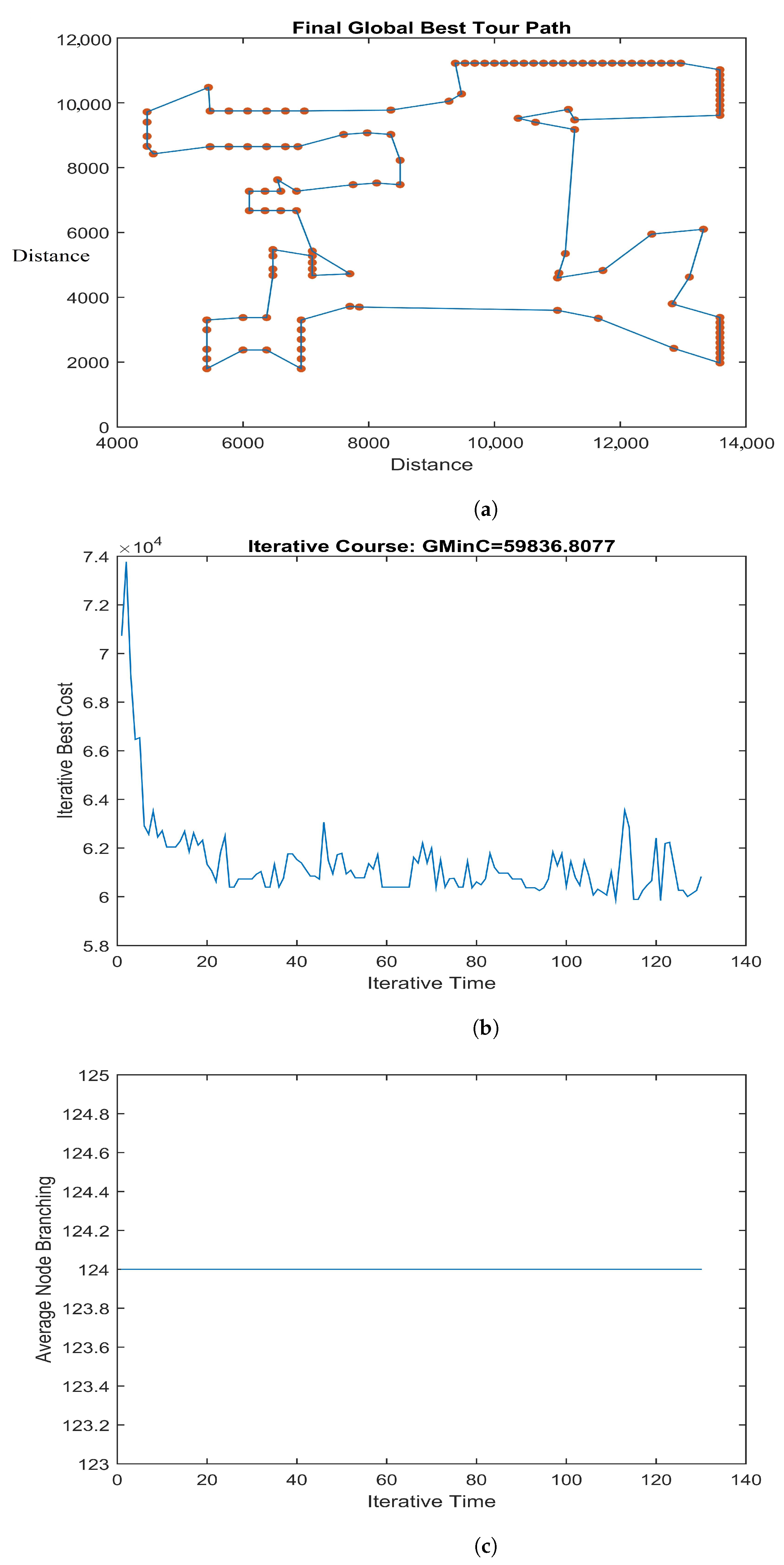
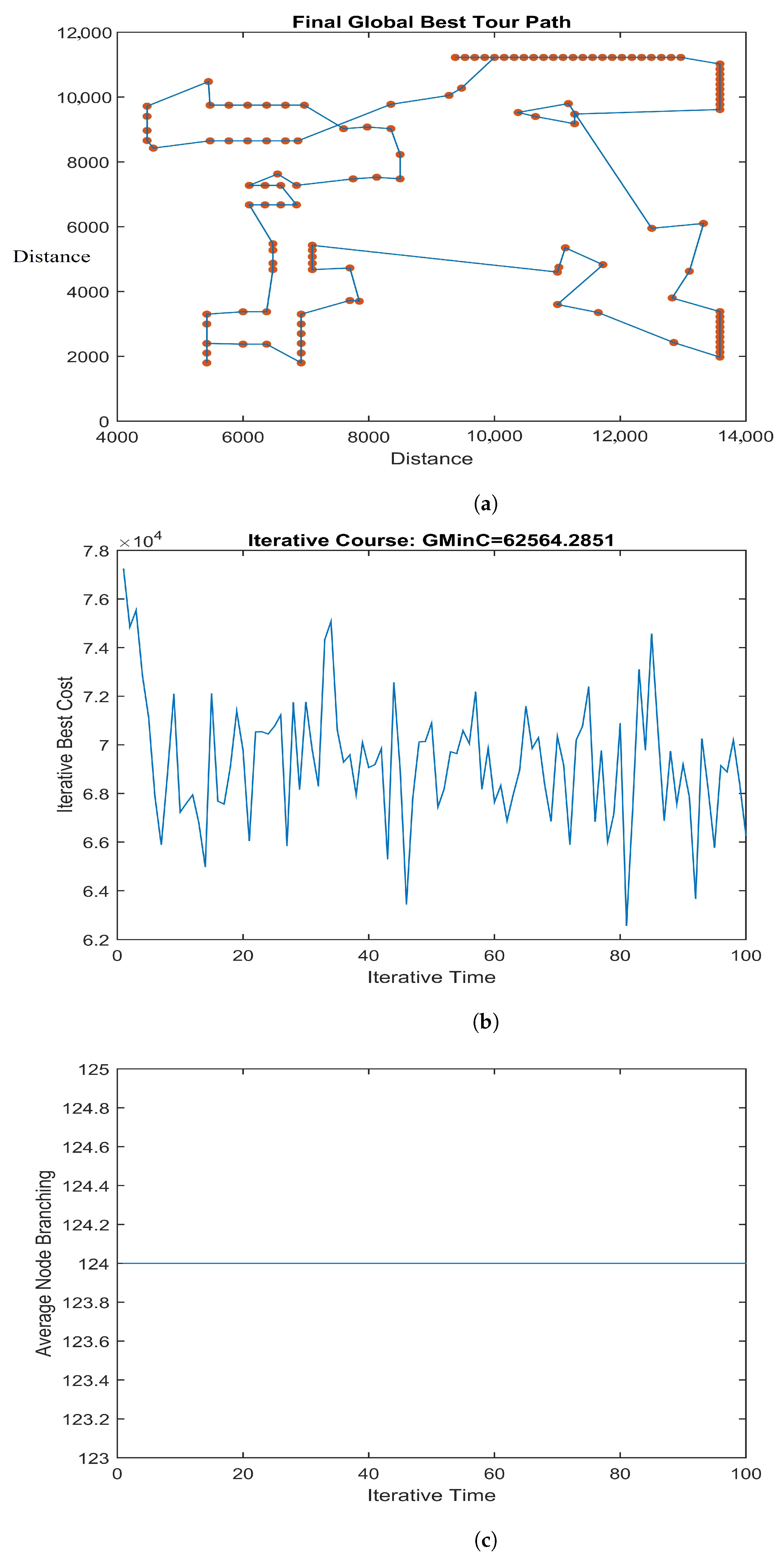
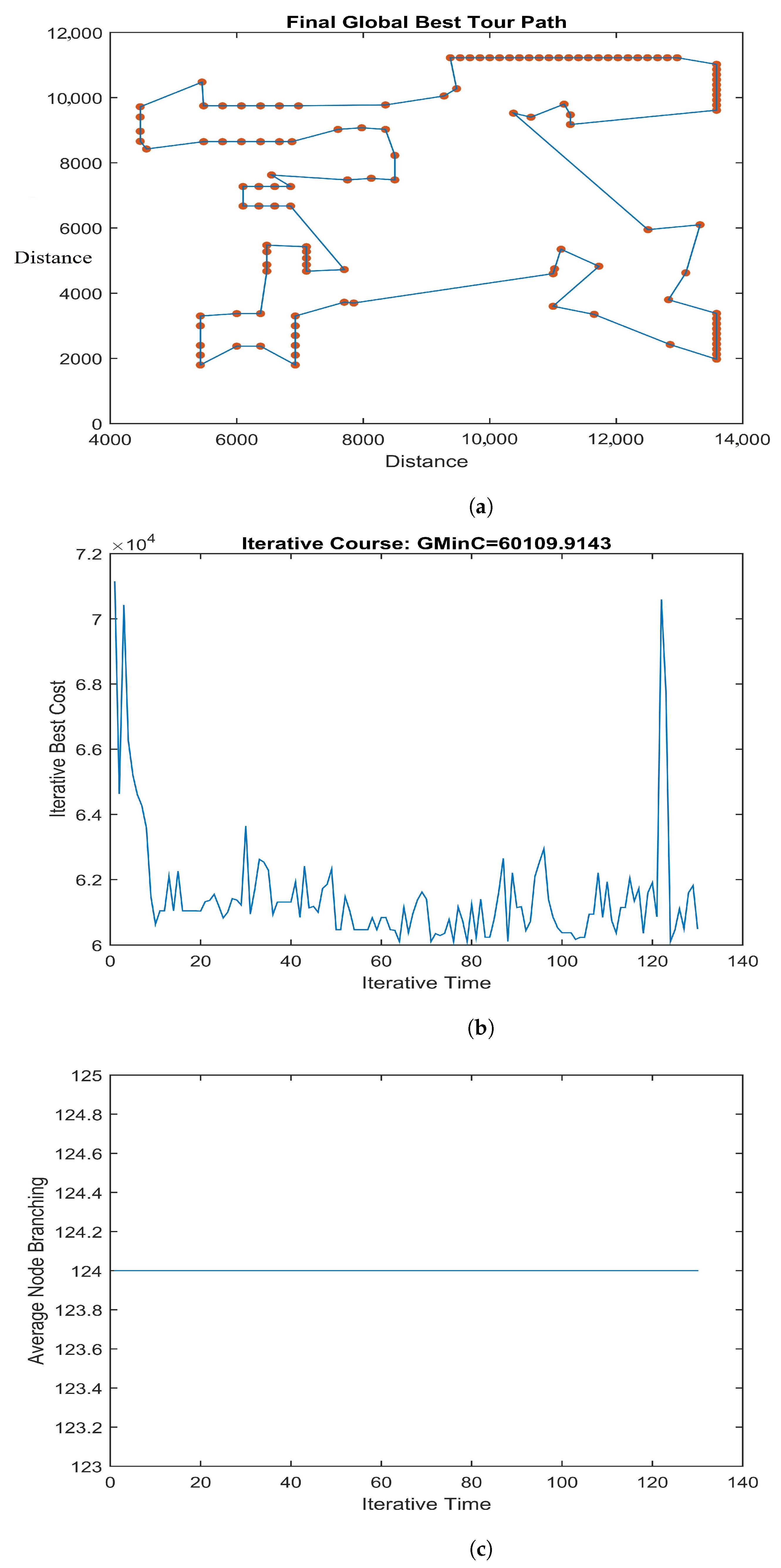
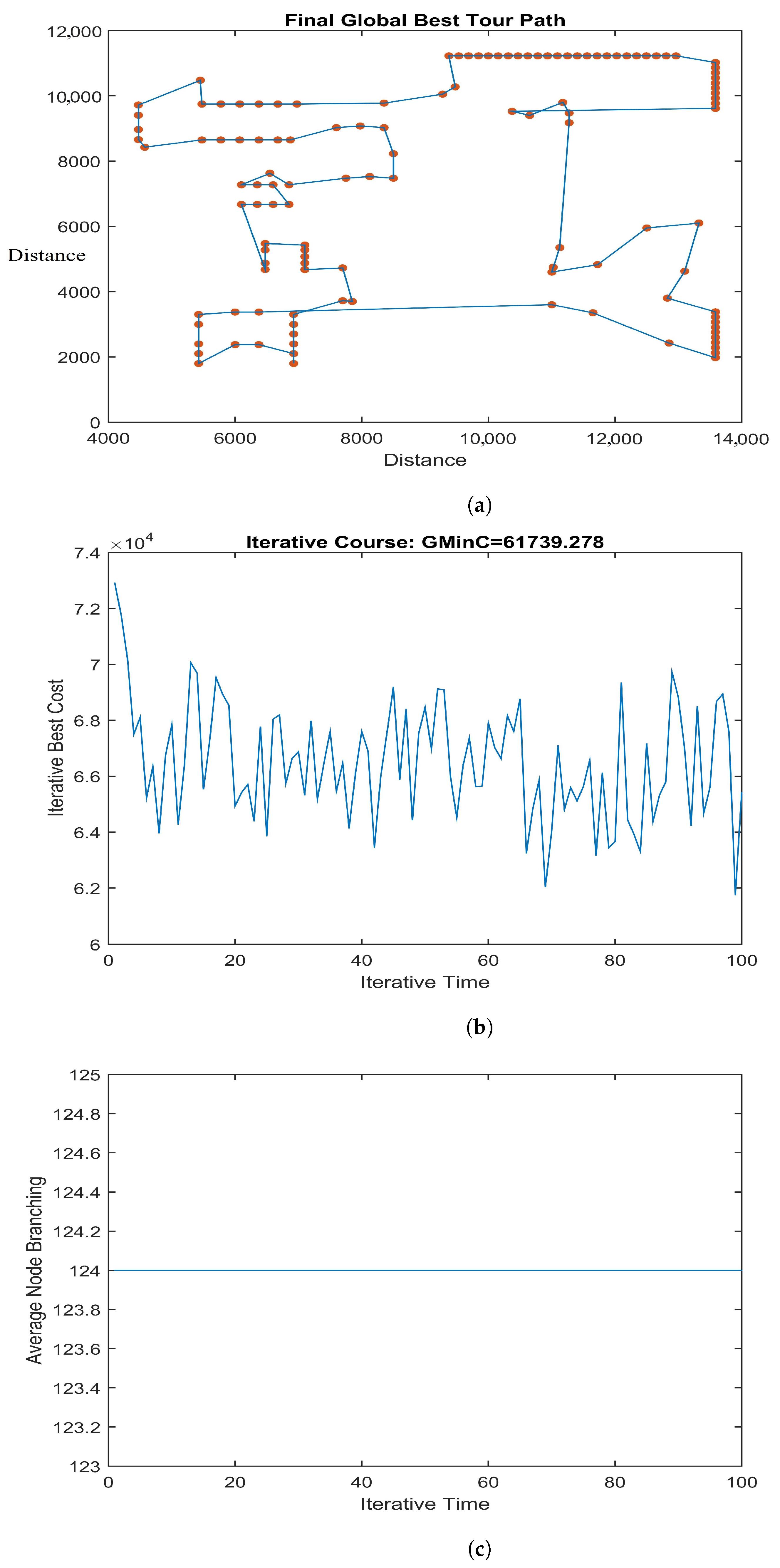
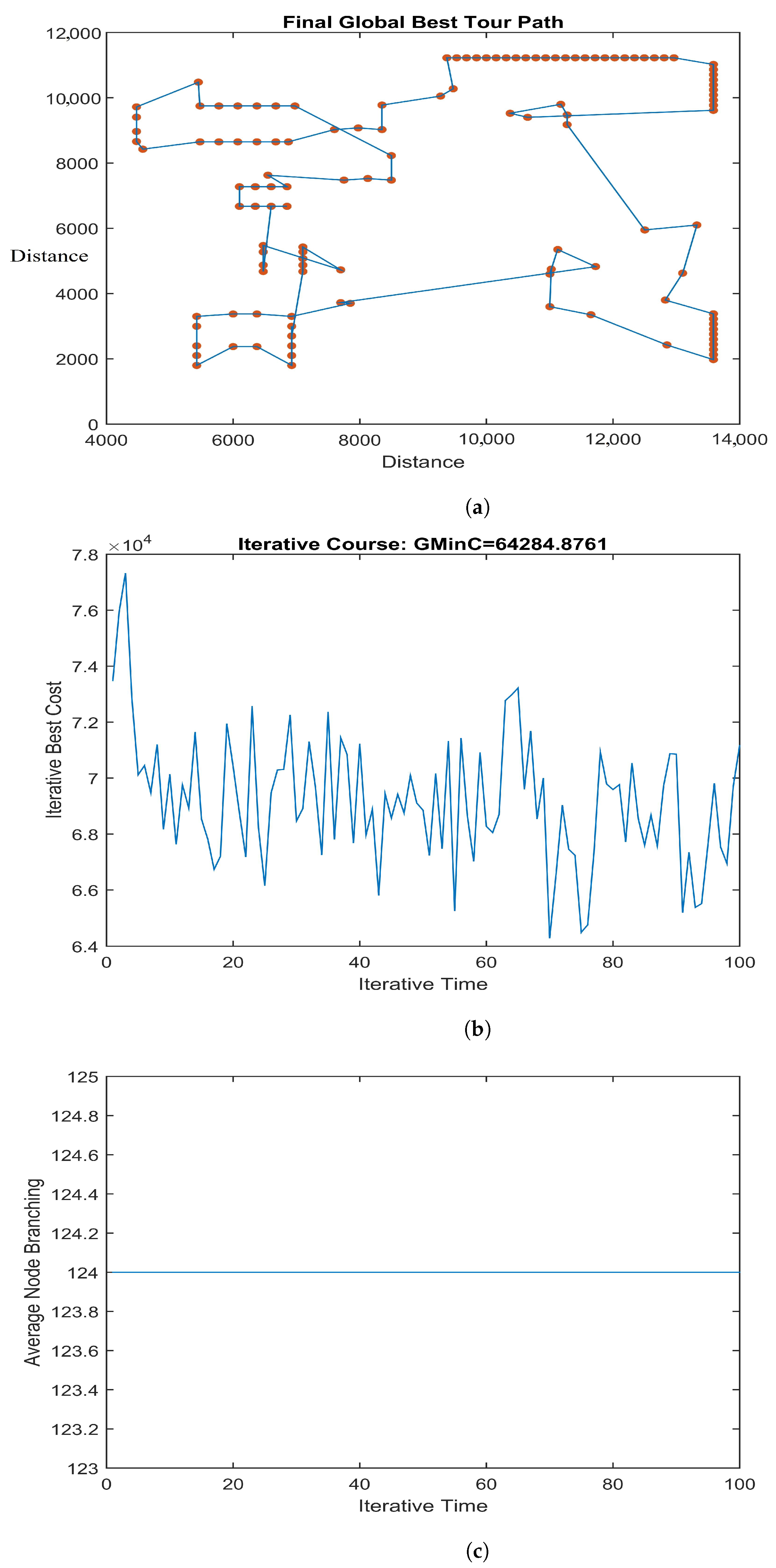
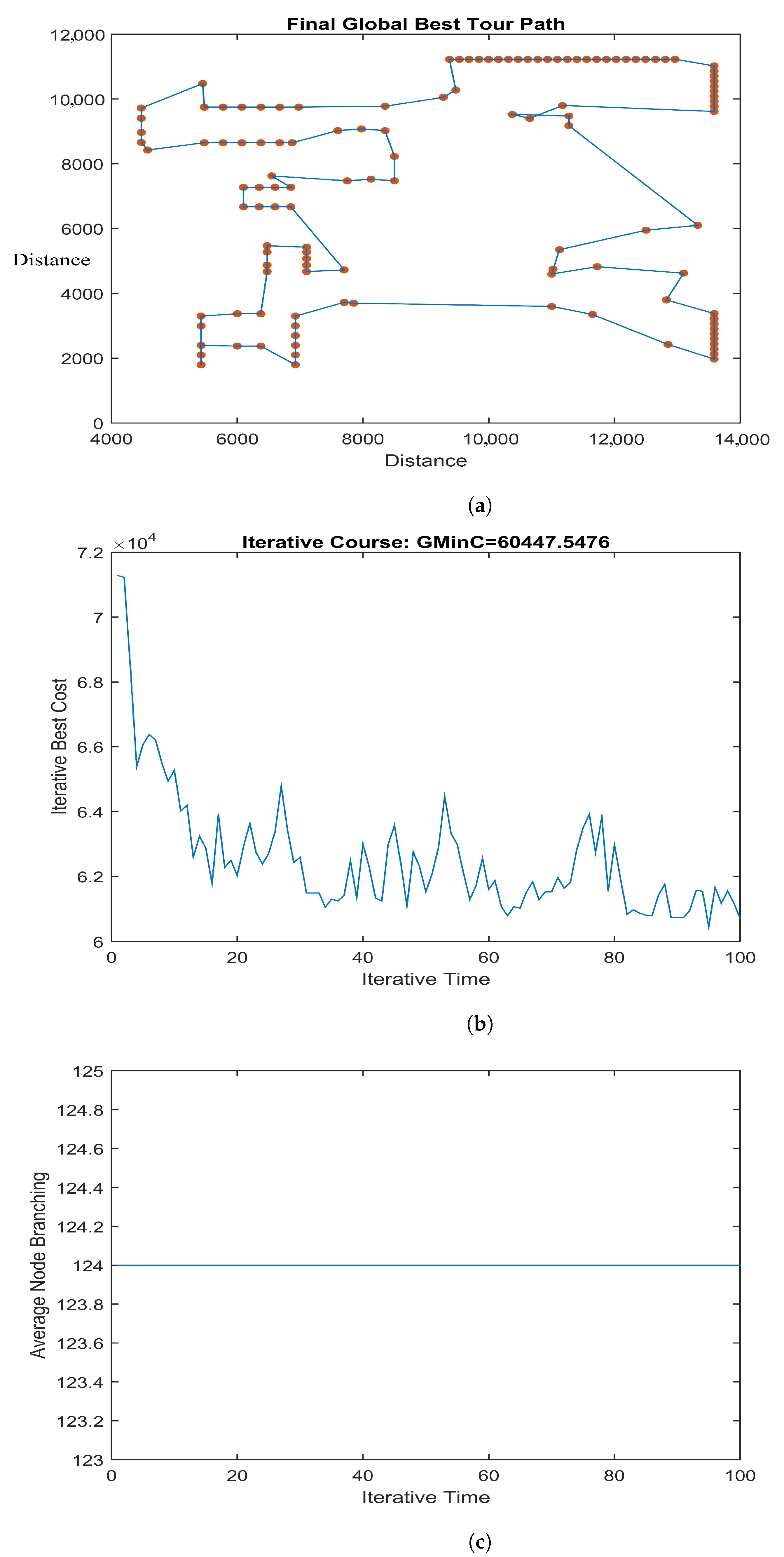
| Proposed BWAS Algo | MMAS | |||||||
|---|---|---|---|---|---|---|---|---|
| Problem | ACO | ACO-PSO | ACO | ACO-PSO | ||||
| Best | Worst | Best | Worst | Best | Worst | Best | Worst | |
| Att48 | 10,436 | 35,522 | 10,401 | 35,071 | 34,504 | 36,539 | 35,123 | 35,514 |
| Berlin52 | 7498 | 8106 | 7441 | 76,091 | 8054 | 8436 | 7663 | 7750 |
| Bier127 | 133,246 | 153,792 | 121,873 | 124,731 | 208,175 | 214,690 | 124,842 | 125,812 |
| kroE100 | 24,391 | 26,382 | 21,736 | 23,746 | 36,189 | 37,975 | 23,784 | 24,077 |
| Lin105 | 16,267 | 18,371 | 13,079 | 14,787 | 25,429 | 27,571 | 14,990 | 15,100 |
| Lin318 | 41,998 | 56,728 | 41,268 | 47,583 | 251,618 | 256,438 | 47,585 | 48,205 |
| Pr124 | 62,532.5 | 66,282 | 60,192.6 | 64,575 | 64,513 | 66,282 | 60,999.3 | 61,496 |
| Pr107 | 47,236.5 | 49,727 | 45,927 | 48,274 | 68,871 | 76,043 | 46,249 | 46,554 |
| Ch130 | 7117.1 | 8367 | 6294 | 6498 | 13,441 | 13,952 | 6473 | 6525 |
| Ch150 | 7446.3 | 7728 | 6593 | 6639 | 16,926 | 17,864 | 6852 | 6886 |
| Ei151 | 436.17 | 451 | 440 | 449 | 438 | 463 | 448 | 452 |
| Ei176 | 564.96 | 567.1 | 559 | 560 | 643 | 691 | 568 | 570 |
| Ei1101 | 627.28 | 682 | 598 | 647 | 973 | 1006 | 700 | 706 |
| kroA100 | 23,979 | 17,393 | 20,478 | 21,837 | 34,573 | 39,422 | 22,387 | 23,096 |
| kroC100 | 22,857 | 24,748 | 18,539 | 20,378 | 36,260 | 39,123 | 21,579 | 21,804 |
| Pr144 | 59,644 | 61,837 | 56,939 | 58,237 | 213,303 | 225,108 | 59,443 | 59,727 |
| Proposed BWAS Algo | MMAS | |||||||
|---|---|---|---|---|---|---|---|---|
| Problem | PSO | ACO-PSO | PSO | ACO-PSO | ||||
| Best | Worst | Best | Worst | Best | Worst | Best | Worst | |
| Att48 | 10,398 | 41,135 | 10,368 | 35,071 | 41,307 | 43,477 | 35,123 | 35,514 |
| Berlin52 | 7383 | 8906 | 7326 | 76,091 | 8752 | 9565 | 7663 | 7750 |
| Bier127 | 178,926 | 188,165 | 121,873 | 124,731 | 188,651 | 196,774 | 124,842 | 125,812 |
| kroE100 | 38,573 | 39,247 | 21,736 | 23,746 | 37,251 | 40,786 | 23,784 | 24,077 |
| Lin105 | 26,914 | 27,452 | 13,079 | 14,787 | 28,149 | 28,925 | 14,990 | 15,100 |
| Lin318 | 41,698 | 159,879 | 41,063 | 47,583 | 155,706 | 158,259 | 47,585 | 48,205 |
| Pr124 | 61,319 | 63,726 | 60,192.6 | 64,575 | 61,727.2 | 65,436 | 60,999.3 | 61,496 |
| Pr107 | 101,181 | 115,431 | 45,927 | 48,274 | 107,160 | 129,760 | 46,249 | 46,554 |
| Ch130 | 10,054 | 11,038 | 6294 | 6498 | 11,179 | 12,083 | 6473 | 6525 |
| Ch150 | 10,084 | 12,156 | 6593 | 6639 | 12,804 | 13,512 | 6852 | 6886 |
| Ei151 | 410 | 499 | 443 | 449 | 511 | 533 | 448 | 452 |
| Ei176 | 665 | 701 | 559 | 560 | 753 | 760 | 568 | 570 |
| Ei1101 | 615 | 902 | 598 | 647 | 905 | 956 | 700 | 706 |
| kroA100 | 35,114 | 38,162 | 20,478 | 21,837 | 37,413 | 39,595 | 22,387 | 23,096 |
| kroC100 | 35,034 | 39,873 | 18,539 | 20,378 | 38,440 | 41,125 | 21,579 | 21,804 |
| Pr144 | 149,376 | 179,837 | 56,939 | 58,237 | 164,662 | 187,458 | 59,443 | 59,727 |
| Proposed BWAS Algo | MMAS | |||||||
|---|---|---|---|---|---|---|---|---|
| Problem | ACO | ACO-PSO | ACO | ACO-PSO | ||||
| Mean | STD | Mean | STD | Mean | STD | Mean | STD | |
| Att48 | 3.9 | 1005.2 | 3.1 | 995 | 4.2 | 1009 | 3.9 | 999 |
| Berlin52 | 16.9 | 502.4 | 15.9 | 410 | 17.5 | 520 | 16.5 | 499 |
| Bier127 | 65.4 | 1115.5 | 64.2 | 995 | 67.2 | 1150 | 66 | 1005 |
| kroE100 | 22.1 | 154 | 21.5 | 132 | 22.7 | 166 | 22.3 | 143 |
| Lin105 | 31.9 | 2012 | 30.4 | 169 | 32.5 | 2040 | 31.8 | 201 |
| Lin318 | 89.2 | 906.2 | 88.5 | 808 | 90.6 | 932 | 89.2 | 880 |
| Pr124 | 68.5 | 2126 | 67.4 | 1884 | 69 | 2232 | 68 | 1934 |
| Pr107 | 32.5 | 307 | 30.5 | 268 | 32.9 | 332 | 31.5 | 302 |
| Ch130 | 76.2 | 209.2 | 74.9 | 200 | 76.8 | 235 | 75.5 | 210 |
| Ch150 | 81 | 27.4 | 79.2 | 20.5 | 81.9 | 28.1 | 80.5 | 235 |
| Ei151 | 81 | 10.2 | 79.5 | 8.4 | 82 | 11.2 | 81.2 | 99 |
| Ei176 | 70.2 | 1.10 | 69.1 | 0.8 | 70.9 | 1.25 | 69.8 | 0.99 |
| Ei1101 | 31.5 | 310 | 29.5 | 266 | 32 | 355 | 30.5 | 310 |
| kroA100 | 22.2 | 309 | 21.5 | 275 | 22.8 | 350 | 21.9 | 299 |
| kroC100 | 22.1 | 402 | 21.5 | 311 | 22.4 | 432 | 21.8 | 365 |
| Pr144 | 80 | 1006.4 | 80 | 984 | 80.5 | 1025 | 80.4 | 1012 |
| Proposed BWAS Algo | MMAS | |||||||
|---|---|---|---|---|---|---|---|---|
| Problem | PSO | ACO-PSO | PSO | ACO-PSO | ||||
| Mean | STD | Mean | STD | Mean | STD | Mean | STD | |
| Att48 | 3.2 | 920 | 2.9 | 890 | 3.9 | 999 | 3.3 | 992 |
| Berlin52 | 15.4 | 410 | 14.9 | 388 | 16.2 | 455 | 15.5 | 403 |
| Bier127 | 64.2 | 992 | 63.5 | 802 | 65.5 | 1005 | 64.1 | 920 |
| kroE100 | 21.1 | 126 | 20.4 | 95 | 22.1 | 161 | 21 | 125 |
| Lin105 | 30.5 | 1830 | 29.8 | 1695 | 31.2 | 2020 | 30.8 | 1725 |
| Lin318 | 88.1 | 887 | 79.4 | 795 | 88.9 | 922 | 85.2 | 822 |
| Pr124 | 66.9 | 1980 | 65.2 | 1910 | 67.8 | 2252 | 67.1 | 1920 |
| Pr107 | 31.2 | 235 | 29.9 | 199 | 32.1 | 322 | 30.5 | 225 |
| Ch130 | 75.1 | 159 | 73.8 | 102 | 76.2 | 205 | 74.5 | 155 |
| Ch150 | 80.3 | 21.5 | 78.5 | 19.6 | 81.1 | 25.1 | 80.1 | 205 |
| Ei151 | 80.5 | 9.4 | 78.4 | 9.1 | 81.4 | 10.4 | 79.9 | 94 |
| Ei176 | 68.9 | 0.9 | 67.1 | 0.8 | 69.7 | 1.2 | 68.8 | 0.89 |
| Ei1101 | 30.1 | 219 | 28.2 | 185 | 31.3 | 295 | 30 | 255 |
| kroA100 | 21.3 | 212 | 20.4 | 175 | 22.1 | 289 | 21 | 220 |
| kroC100 | 21.5 | 355 | 20.5 | 302 | 21.9 | 400 | 21 | 355 |
| Pr144 | 78.6 | 958 | 77.9 | 898 | 79.4 | 992 | 78.4 | 958 |
Publisher’s Note: MDPI stays neutral with regard to jurisdictional claims in published maps and institutional affiliations. |
© 2021 by the authors. Licensee MDPI, Basel, Switzerland. This article is an open access article distributed under the terms and conditions of the Creative Commons Attribution (CC BY) license (https://creativecommons.org/licenses/by/4.0/).
Share and Cite
Qamar, M.S.; Tu, S.; Ali, F.; Armghan, A.; Munir, M.F.; Alenezi, F.; Muhammad, F.; Ali, A.; Alnaim, N. Improvement of Traveling Salesman Problem Solution Using Hybrid Algorithm Based on Best-Worst Ant System and Particle Swarm Optimization. Appl. Sci. 2021, 11, 4780. https://doi.org/10.3390/app11114780
Qamar MS, Tu S, Ali F, Armghan A, Munir MF, Alenezi F, Muhammad F, Ali A, Alnaim N. Improvement of Traveling Salesman Problem Solution Using Hybrid Algorithm Based on Best-Worst Ant System and Particle Swarm Optimization. Applied Sciences. 2021; 11(11):4780. https://doi.org/10.3390/app11114780
Chicago/Turabian StyleQamar, Muhammad Salman, Shanshan Tu, Farman Ali, Ammar Armghan, Muhammad Fahad Munir, Fayadh Alenezi, Fazal Muhammad, Asar Ali, and Norah Alnaim. 2021. "Improvement of Traveling Salesman Problem Solution Using Hybrid Algorithm Based on Best-Worst Ant System and Particle Swarm Optimization" Applied Sciences 11, no. 11: 4780. https://doi.org/10.3390/app11114780
APA StyleQamar, M. S., Tu, S., Ali, F., Armghan, A., Munir, M. F., Alenezi, F., Muhammad, F., Ali, A., & Alnaim, N. (2021). Improvement of Traveling Salesman Problem Solution Using Hybrid Algorithm Based on Best-Worst Ant System and Particle Swarm Optimization. Applied Sciences, 11(11), 4780. https://doi.org/10.3390/app11114780







